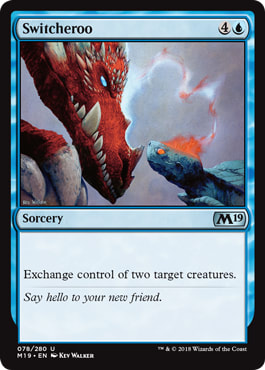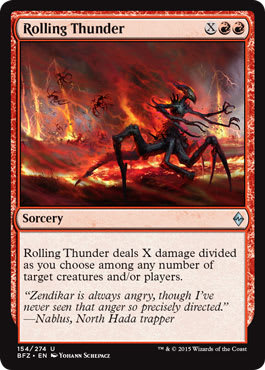Of course, in true Magic-player fashion, I found myself longing to play competitively again once previews for the new fall set began. Battle for Zendikar Limited was shaping up to be unlike anything I’d experienced before, and I was eager to start cracking packs. When my The Girlfriend Bracket cohost Kriz offered me a place to stay and a ride to Grand Prix Madison, I jumped at the opportunity. I’ve always wanted to travel farther and attend more Grand Prix, but this one would challenge me to assess the new Limited format at the same speed as the pros. I booked my ticket and flew out to the Midwest for the second time in my life.
I only had about two weeks to prepare for the Grand Prix, and I admit my preparation wasn’t ideal. I played in four tournaments during prerelease weekend, and once BFZ went on sale, I cracked a Sealed pool every day for a week. As I pored over the cards and arranged them into piles, I became aware of just how alone I was, theorizing about a set I’d barely played so I could travel two thousand miles away by myself to play in a Grand Prix. I wish I were still on a team, I thought. I had the same thought again after I dropped from the event with an X–2–1 record.
The Madison Maneuver
Grand Prix Madison was a historic event for a number of reasons. It was my ninth Grand Prix in two-and-a-half years and the first time I’d traveled east of the Mississippi for a Magic tournament. It was the last Grand Prix that Midwest stalwart Legion Events would be running for the foreseeable future. And it marked the debut of the new Sealed deck-swap procedure that Wizards of the Coast had announced just two days prior.
Here’s how the player meeting went down. After we filled out our media wavers, we handed them in to the judges in exchange for deck boxes, each of which contained six booster packs and a folded-up Battle for Zendikar Deck Registration Checklist. The players on one side of the table (Players A) began by removing the six packs from the deck boxes and verifying with the players across from them (Players B) that they had all been marked. (The judges had apparently taken a star-shaped hole-puncher to the ends of each of my packs.) Then, Players A opened the first pack and laid out the contents so that they were clearly visible to Players B. Once Players B acknowledged that they had seen all the cards—a simple nod of the head or an “okay” is sufficient—Players A scooped them into the deck boxes and repeated the process for the other five packs.
Then, the players switched roles, and Players A checked all Players’ B cards, following the same procedure. I had to resist the urge to open all the packs at once, as I had been taught under the old regime, but overall, the verification process went rather smoothly. I found it helpful to turn the cards over after opening each pack and lay them out facing the player across from me; the procedure goes much faster when you aren’t paying attention to the cards you open.
The rest of the deck-swap procedure was familiar: Player A and I exchanged deck boxes, I registered his pool using the checklist, and then, we swapped back and began building. One potential problem with the new process is that replacing the checklist-verification process with a card-by-card verification process will lead to more clerical errors by registrants and, quite possibly, some unintended game losses for players. I encourage registrants to double-check their work and players to look over their pools before building. I’m quite happy with the new system overall—I didn’t have to worry about what I’d do if I opened an Expedition land—but I plan on being more vigilant about pool registration at upcoming Preliminary Pro Tour Qualifiers, where my odds of receiving a deck check are much higher.
Building for Battle
When I received my pool, I organized the cards by color and relative strength and assembled a B/G ramp deck similar to many of the decks I’d built in the weeks leading up to the tournament. Black gave me access to removal and early ingesters, while green provided powerful Processors and countless token-makers. I loved the versatility of Scions – they could attack, chump-block, ramp me, or provide fodder for Bone Splinters and Smothering Abomination—and was happy to have as many of them in my deck as possible. Like many decks I’ve come across in this format, this one seemed consistent and synergistic, but not necessarily powerful; I assumed I’d be winning a lot of games by attacking with swarms of 1/1s and then making other 1/1s to block. When a friend asked me how I felt about my deck, I said, “It’s probably a B or a B−. Definitely the best Smothering Abomination deck I’ve built so far.” Perhaps I wasn’t giving myself enough credit—going wide is a strong strategy in a format with such a low power level, where few cards have the power to end the game on the spot.
B/G Ramp ? Battle for Zendikar Sealed | Hallie Santo
- Creatures (18)
- 1 Blisterpod
- 1 Brood Monitor
- 1 Carrier Thrall
- 1 Culling Drone
- 1 Eldrazi Devastator
- 1 Eyeless Watcher
- 1 Giant Mantis
- 1 Malakir Familiar
- 1 Rot Shambler
- 1 Ruin Processor
- 1 Sludge Crawler
- 1 Smothering Abomination
- 1 Snapping Gnarlid
- 1 Wasteland Strangler
- 2 Dominator Drone
- 2 Void Attendant
- Spells (5)
- 1 Complete Disregard
- 1 Unnatural Aggression
- 1 Bone Splinters
- 1 Demon's Grasp
- 1 Swarm Surge
- Lands (17)
- 7 Forest
- 8 Swamp
- 1 Evolving Wilds
- 1 Spawning Bed
Two rules of thumb I’ve discovered when dealing with BFZ Sealed are, first, look for synergies, and second, try to stick to two colors. For a set with a mechanic that encourages players to build three-, four- and five-colored decks, Battle for Zendikar is severely lacking in mana-fixing. The common and uncommon land cycles offer little assistance, so the only true mana-fixing can be found at rare and in green. It’s always possible to use Evolving Wilds to splash for a powerful removal spell or two, but there are countless playable cards in the set that don’t fit in every archetype and are therefore not worth splashing for. Upon finding a Canopy Vista and a Shambling Vent in my pool, I scanned my pile of white playables, looking for anything worth including in my deck, and I was met with only tiny Allies and flyers.
When Kriz and I were driving back to her house from the airport, she asked me about Battle for Zendikar Sealed strategies, and I dutifully reported that I preferred black, green, and blue to red and white. While finding the right balance of ingesters and Processors is critical; these colors have tended to provide the most cards that pull their own weight. In a format of hulking Eldrazi, I want solid green creatures at every size to outrace the monsters, tussle with them, or help ramp into giant creatures of my own. In a format of board stalls, I want evasive blue creatures like Eldrazi Skyspawner, Mist Intruder, and Benthic Infiltrator. In a format in which small creatures can have a giant impact on the game, I want removal spells like Complete Disregard and versatile creatures like Silent Skimmer, which safely blocks most flyers and the format and can provide inevitability on its own. I want Bone Splinters in my B/G tokens decks and Demon's Grasp for the inevitable Bane of Bala Ged or Guardian of Tazeem. As far as I’m concerned, Zendikar is the Eldrazi’s world; the Allies just live in it.
I have built solid white and red decks, of course, and the two colors boast quite a few important cards. White has some excellent removal, with Gideon's Reproach and Sheer Drop at common, Stasis Snare and Roil's Retribution at uncommon, and perhaps the best card in the format, Quarantine Field, at mythic. But there are also quite a few white cards that only care about Allies or that are dedicated to supporting the W/B life-gain strategy. (I’m looking at you, Stone Haven Medic. Have fun blocking Snapping Gnarlids!) Red has a similar problem: Its creatures are too easily pigeonholed into devoid, landfall, and Allies strategies that lend themselves more to Draft than Sealed—though it does feature two of the most formidable uncommons in the format: Rolling Thunder and Turn Against.
Anyone who remembers Tempest can tell you how devastating Rolling Thunder is, and things haven’t changed much—the spell is always at least a two-for-one, unless your opponent is aiming it at your face. Turn Against is a much different threat, and while I expect it to become a bit worse as more players learn to respect it, the card still has devastating potential. I was knocked out of Day 2 contention by a player who happened to have both Turn Against and Rolling Thunder in what can best be called a Jeskai Awaken deck. I played around Turn Against pretty deftly in Game 1—my opponent had to resort to stealing one of my 1/1s and using it to block another—but my fear of Turn Against ended up costing me the match. My opponent seemingly always had 5 mana open, so I only felt comfortable attacking with my largest creature, a Ruin Processor that had turned a Disregarded Eldrazi Skyspawner into fuel. The Processor never got through, however, as my opponent had plenty of chump-blockers around. I had a much better board presence—seven creatures to his four—and had he stolen my 7/8 and eaten one of my smaller creatures, I still would have been in a decent position. I couldn’t swing all-out, however, should he decide to take the damage and retaliate by stealing the Processor on his next turn, so I continued forcing chump-blocks until he finally cast a Planar Outburst I hadn’t seen in previous games. A big Rolling Thunder finished me off.
I was disappointed that I’d missed yet another chance at Day 2, but I’m pleased with the format and happy to have my drive back. What I love most about Battle for Zendikar Limited is how skill-testing the games can be: With few utterly game-breaking cards, the onus is on us to build the most synergistic decks possible and know the format well enough to make the best in-game decisions. I look forward to heading to BFZ Sealed PPTQs in the coming weeks; please use this as a guide if you’ll be doing the same.




























